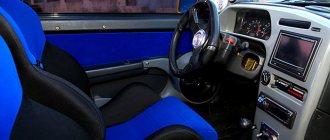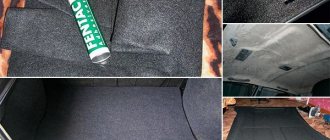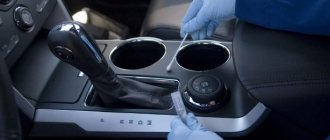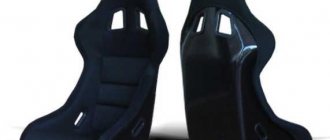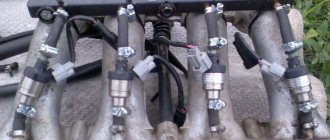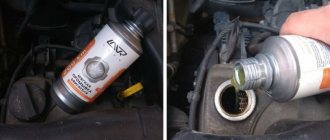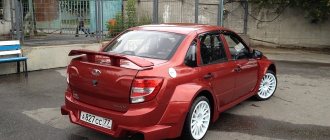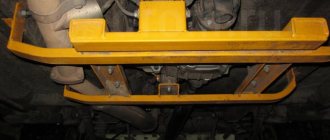Due to its durable composition and good moisture resistance, carpet Ideal for car interior treatment, as well as for subwoofers and speaker systems.
In order to cover the interior of a car with carpet yourself, you do not need to have any special skills, you just need to follow the clear instructions.
First you need to prepare all the available tools:
- carpet fabric;
- glue;
- scissors;
- hair dryer;
- rollers.
After preparing all the parts, you can start covering with carpet :
1. When purchasing carpet, pay attention not only to the color and density of the fabric, but also to its width. If the width is insufficient, you will have to adjust another roll of carpet, which can cause joints to form, which looks unsightly. Also, the fabric should stretch well in different directions.
2. Along with purchasing carpet, also purchase glue. The glue must not only be highly durable, but also heat-resistant. Many stores that sell this kind of fabric have special aerosol adhesives. .
3.Remove as many removable parts as possible from the car interior - sills, door handles, etc.
4. Clean all surfaces from dirt, and run the degreasing mixture over the plastic. It is worth noting that before work, the surface must be completely dry.
the carpet itself . After the glue has dried (at least 20 minutes), lean the carpet against the surface. Try to get exactly in the right place, and also make sure that there are no uneven spots or bumps.
6. upholstering the interior with parts of a simple shape, then more complex ones. At the end, it’s worth starting with the elements upholstered with fabric (car doors, ceiling, etc.).
7. To cover more complex shapes, prepare a piece of carpet sewn from several parts of fabric. The overall size of the piece should be slightly smaller than the part being processed, but keep in mind that slightly less, this means that when stretched it will become exactly the right size for the part.
8.When the carpet is laid, heat it with a hairdryer. It is important to note here that when heated, the glue will set better, and so will the carpet, so you must be sure that the canvas lies flat and in its place.
These were instructions for covering the interior with carpet, from which you learned the basic principle of working with the canvas. It is also important to say that the moment with the choice of glue is very important, since it is precisely this that ensures the reliability of the mounted canvas, so try to choose high-quality glue for the carpet.
Video: “Do-it-yourself interior reupholstery with carpet”
The material has good noise-absorbing properties, is antistatic, resistant to moisture, and is perfectly moldable. They are used to cover surfaces of various shapes - car doors, acoustic shelves, trunk, ceiling, podiums, panels, subwoofers.
Carpet is available in different colors; the material does not fade over time, and its dense non-woven structure ensures high wear resistance and durability of the coating.
Why is a car interior reupholstered?
The interior of many cars is decorated differently. Some doors are covered with soft fabric or leather substitute, while others have plastic panels. The same goes for the car's ceiling and trunk lid panel. Minor dirt on the casing coating can be removed by dry cleaning or simple washing. However, complex damage in the form of burns or cuts is quite difficult to eliminate using the simplest methods. In this case, upholstery is simply necessary.
Of course, some car owners may not encounter such a procedure, since they are careful about cleanliness and order in the car interior and require strict compliance with these standards on the part of passengers. However, there are also those who reupholster the interior not for the first time.
However, this procedure only applies to sheathing made of soft material. In the case of plastic, everything is quite simple. The manufacturer has provided a number of special standards that make it possible to replace plastic elements with new ones with exactly the same dimensions and fastening methods.
Additional tips and tricks
Upholstering a car interior in a workshop is an expensive proposition. But you can veneer plastic and metal surfaces and wooden cases yourself, but you need to do the work carefully and carefully.
If it is not possible to find an odorless agent for gluing the carpet, the parts must be unscrewed and removed, and cladding should only be started in a ventilated room. It is not recommended to immediately install a sheathed subwoofer or ceiling into the interior. The smell disappears in at least 3 days.
The material has good noise-absorbing properties, is antistatic, resistant to moisture, and is perfectly moldable. They are used to cover surfaces of various shapes - car doors, acoustic shelves, trunk, ceiling, podiums, panels, subwoofers.
Carpet is available in different colors; the material does not fade over time, and its dense non-woven structure ensures high wear resistance and durability of the coating.
What material is used for interior upholstery?
Most often, only damaged seats are covered. Doors, in this regard, suffer extremely rarely, and the ceiling is quite difficult to spoil. However, this phenomenon also occurs. Therefore, after detecting the corresponding damage, it is important to decide on the future covering material.
When the question of upholstery is raised, leather comes to mind for many people. After all, this is practically the most practical and beautiful material. But, since it has a fairly high cost, it is bypassed, making a choice towards the material provided in the list below.
1. Carpet . This material is characterized by low cost and great availability. Reminds me of a thin layer of carpet. It has a wide selection of colors and is easy to use.
2. Leather substitute . An excellent alternative to genuine leather, however, it has a rather big disadvantage - it is an unpleasant odor in the cabin, which takes quite a long time to dissipate.
3. Alcantara. It has a more attractive appearance and is similar to suede.
In addition, it has a high margin of strength and durability.
Cover technology
Interior upholstery always starts with the seats, as they are subject to wear and tear more often than other decorative elements. To do this, the old sheathing is cut along the seam and will act as a template for the pattern. When cutting new pieces, try to make a small supply. It will need to be folded when sewing, in addition, the bend will stretch the skin well and will have a fairly attractive appearance.
There will always be doors on the second line. To do this, the removable panel is disassembled into separate parts and sheathed individually. This approach will allow you to show creativity, for example, sheathing different elements with different materials. If the plastic is preserved normally, then it does not need to be sheathed. It also looks good compared to other materials.
The ceiling is the most difficult area of work. To begin with, the old casing is dismantled, lamps and everything that interferes with further work are dismantled. If you plan to cover the ceiling with a leather substitute, it is recommended to heat it first. As the temperature increases, its elastic properties will improve, and it will stretch quite nicely. The edges of this material are secured with glue. Then ceiling panels, handles, hooks are applied, cutouts are made for the lighting shades and their further installation occurs.
It is recommended to choose one color for the ceiling, doors and all other parts. This makes the car look more solid and attractive.
To cover the trunk, it is not necessary to use the above-mentioned materials. Typically, panels for such doors are made of plastic in compliance with the required dimensions. Fastening is carried out using self-tapping screws. However, there are models for which this panel is not provided. In this case, you will have to drill the holes for the screws yourself. As a last resort, you can use the above-mentioned materials and simply cover the trunk lid.
Finishing features
At the very beginning of the process, you need to make patterns of the surface on which the material will be glued. Measure all dimensions and add 2-3 cm to them for bending. Carpet can be glued both to old material and to a clean surface. It all depends on the wishes of the car owner. You can first try gluing it onto old material and see how it looks.
Depending on what kind of glue you use, the gluing option will be different. If you have glue that does not hold temperatures above 50C, for example, furniture glue, then use a thin brush to spread it over the surface of the material and product in a thin layer evenly. Then you need to wait 2 minutes for the solvent to evaporate from the glue, press and wait until it sets. Complete setting occurs after 24 hours.
If you bought aerosol glue, then you should spray it in a small layer at a distance of 15 cm. Then wait 2-3 minutes and press the carpet firmly. Complete setting will occur after 24 hours. During this time, it is better not to touch the product and let it dry thoroughly.
How to glue a car carpet DIY interior tuning
- Glue 88. Cheap, elastic (which is important when gluing vibrating surfaces), and grips well, which is why it is loved by supporters of do-it-yourself interior reupholstery. But there are also a number of disadvantages. Firstly, it has a rather strong unpleasant odor (fortunately, it is not persistent, so it disappears quickly). Secondly, it does not tolerate heat well. On the rear shelf in the summer, a carpet glued with 88 will not last until the end of summer;
- PVA. It is better to avoid it altogether: it appears stained on dark fabrics, becomes tanned, as a result of which, due to mechanical deformations, it ceases to hold surfaces together and loses its properties due to humidity;
- Moment and its analogues. If you don’t know how to work with lightning speed, it is not recommended to resort to them: adhesives smear quite poorly, but harden literally in a minute;
- Specialized adhesives like JOWAT or similar. Heat-resistant (heating up to +100°C is indifferent to them), odorless, elastic, economical in consumption. The only drawback is that they are expensive;
- Furniture adhesives. The choice is questionable; in each individual case you need to be interested in temperature resistance and the degree of adhesion to plastic. Moreover, they are not too cheap;
- Usually people use a combination: most of the interior is covered with 88 glue, and vulnerable areas like the rear parcel shelf are covered with specialized glue.
Suitable adhesive options
Depending on the quality of the surface, the product is selected. Some people prefer to combine formulations.
- Glue 88. Has a strong chemical smell and is difficult to erode. Does not tolerate high temperatures well. Covering the floor is the best option, but covering the panel does not make sense, since it melts under direct sunlight. It tolerates shaking well in the car. For application, you can use a regular paint brush.
- PVA. There are mixed reviews. In the cold it loses its elasticity, which limits its scope of application. Not recommended for dark-colored carpet - it can leave white marks if the material is not used carefully and stretched. Apply with a brush. Does not tolerate humid atmosphere.
- Moment. It has a wide range of different varieties. The price for a small tube is high. Most often it has the consistency of a paste, so it is difficult to apply to a large surface. Optimal use of the spatula. The paste hardens quickly, so you need to work quickly.
- Import. There are lines from many foreign manufacturers. Recommended by experienced craftsmen. They are consumed minimally and are distributed with a spray gun. Resistant to temperature changes. However, they belong to a high price category.
- Aerosol. Reviews are mixed. Be careful when choosing, as a wide range of glues can lead to confusion. The temperature on the cylinder must be above 40 degrees at a constant fastening time. When facing, it is important to cover two surfaces with the composition. The aerosol spray becomes temporary when applied to one surface.
- Titanium. It has a liquid structure, odorless and colorless. One of the advantages is the noticeably low cost. Titanium is a strong composition, but does not have good elasticity.
Repairing the dashboard after the airbag deployed. If this happened
- Naturally, the torpedo will have to be dismantled. Before covering, it is washed with liquid soap and a stiff brush, and then degreased;
- In places of damage, the plastic is primed with a suitable composition;
- Small scratches (for example, from flying glass) are sanded and puttied;
- The edges of the tear from the fired pillow are combined as tightly as possible, secured from below and also sealed with putty;
- After drying, all sealed areas are treated with soil again;
- It is better to start pasting from the most protruding element - the visor on the dashboard. A small area is coated with glue, the same is done with a piece of leatherette intended for it. After 5 minutes, it is fixed on the top of the visor and warmed up with a hair dryer, set to the minimum temperature and moved 10 centimeters from the surface;
- To fit complex figured outlines, the material is pre-heated and gently stretched, after which it is ironed with careful elimination of folds;
- Small cracks at the joints are pressed close to the plastic of the torpedo with a plastic sharpened spatula;
- When the entire relief is covered, a kind of “skirt” of excess material will remain along the entire lower perimeter of the torpedo. It is trimmed, the edge is turned inside out, pulled tightly and also glued.
Pasting with carbon film Priora interior
| You can approach the issue of tuning a car interior from different angles, for example, upholstering the interior in leather or painting it. Currently, carbon-effect vinyl film is popular. In this article we will tell you how to apply carbon film in the interior of a VAZ 2170. |
How to glue carbon film
- Cutting out the required piece of film with a margin of 15-20mm at the edges.
- Degreasing the part.
- Removing the protective layer from the film.
- Gluing the part to the film.
- Smoothing the film over the entire surface of the part.
- We glue the edges and bends using heat with a hairdryer.
- Cut holes in the part (if any).
Vinyl film carbon in the interior of Lada Priora
Center console in carbon (author of black version and author of white), dismantling instructions:
Priora door handles and door trim in carbon fiber (author, author), dismantling instructions:
Carbon fiber for the Priora instrument cluster (author of the black version, author of the white carbon version), dismantling instructions:
Priora carbon panel (author, author): By the way, in addition to pasting with vinyl film, there is another interesting way to change the interior of a car - flocking.
How to work with carpet
Thanks to its durable composition and good moisture resistance, carpet is ideal for car interior treatment, as well as for subwoofers and speaker systems.
In order to cover the interior of a car with carpet yourself, you do not need to have any special skills, you just need to follow the clear instructions.
First you need to prepare all the available tools:
After preparing all the parts, you can start covering with carpet :
1. When purchasing carpet, pay attention not only to the color and density of the fabric, but also to its width. If the width is insufficient, you will have to adjust another roll of carpet, which can cause joints to form, which looks unsightly. Also, the fabric should stretch well in different directions.
2. Along with purchasing carpet, also purchase glue. The glue must not only be highly durable, but also heat-resistant. Many stores that sell this kind of fabric have special aerosol adhesives. .
3.Remove as many removable parts as possible from the car interior - sills, door handles, etc.
4. Clean all surfaces from dirt, and run the degreasing mixture over the plastic. It is worth noting that before work, the surface must be completely dry.
How to cover a torpedo List of materials and steps
- Very high resistance to moisture and temperatures (including temperature changes);
- Antistatic properties that significantly prevent contamination;
- No need for special care;
- Acceptable, relatively low price;
- At the same time, reupholstery work does not contain any difficulties and is even accessible for independent execution;
- An equally interesting option is vinyl artificial leather. With a reliable imitation of the natural one, it wins in comparison with it in several respects at once;
- Resistance to temperatures and ultraviolet radiation;
- Easy to clean without regular maintenance;
- Immunity to household liquids: oils, detergents/cleaning agents, chlorinated water, disinfectants;
- Biological resistance: does not rot or mold;
- High wear resistance: it tears and cuts much worse than natural leather, and wears out very slowly. And again, it is not difficult to fit and has an affordable price.
Tell me how to cover complex shapes with carpet
So yesterday I was fussing over the sheathing from the trunk, it has a complex concave shape, but I don’t understand how to cover it so that there are no folds left.
Shelves and subs are no problem to cover, no folds. how to cover complex shapes, maybe some thin carpet, or how to wet it so that it fits the shape?
Who will share their tricks and wisdom?
The best thing that happened was to make two folds or seams.
MITSUBISHI CRAZY CD5W
Mmm, you have to go to the garage, well, the inner skin of the wing is in the trunk, it is concave and has many angles. Maybe you need to look for a thinner carpet, or wet it before laying it and dry it, and only then glue it.
The Carpet stretches, but not as much as we would like. IMHO. Cut off the folds and join end to end. The butt seams on the carpet are barely noticeable.
Here is one of the first photos, these are the podiums for the amplifiers, already covered with fiberglass. Actually, where the holes are for ventilation, there is a carpet and it won’t be visible, it won’t be visible, the folds are where they are outlined in red, they are not that big, but I would like without them.
What’s so complicated about it, if you’re from Omsk, come and do it
It’s a late answer, of course, but it won’t come out, I had to cut it in two places, but it’s invisible, so I don’t worry))))), the carpet can stretch a little and it’s possible, but there’s no way to tighten it.
Another option would be to glue it first along the outer contour, and then pull it inward, but the carpet will not stretch that much))).
This is my first piece in my life that I have tightened, I have never done this before, by the way it turned out well for the first time, I am pleased, for some reason I was immediately sure that I could tighten such a difficult shape for me, and so it turned out
there were also not large wrinkles, I cured everything with an iron through the fabric, and in one place there was apparently a lot of glue, so it turned out to be not a big stain after the iron, light green in color, well, you can’t see it in the trunk, the place is so closed, just be careful, if the glue has soaked the carpet, it will come through then you should not iron it with an iron.
Glue in the form of a spray, that’s all the wisdom. It kind of “dissolves” carpet a little, so it can be used to cover a surface of almost any complexity.
Should I close this thread so as not to stir up a new one?))))
The idea arose to raise the floor level in the trunk of the Kalina hatch. The planned material is 12-15 mm plywood, which I think will be covered with carpet. I think that this thickness will be enough so that under a 10″ subwoofer in the rear section it will not sag, especially since there will be intermediate spacers under the cover. In topics with similar names there were all sorts of tips on gluing. I liked the version of the transparent construction adhesive “Master”. That was advice from three years ago. Has nothing changed during this time in the technology of covering plywood with carpet? Will just glue be enough, or is there another option to shoot the carpet onto the plywood from the back with a construction stapler? Or is it better not to do this?
DIY ceiling reupholstery
Do you want to replace your car's old headliner material, change the color, or restore your car's headliner after an airbag deployment? At the same time, you do not plan to seek help from specialists. Be prepared for the fact that reupholstering the ceiling with your own hands will take quite a lot of time and sometimes require an investment comparable to reupholstering the ceiling in a car workshop.
So, how do you reupholster the ceiling yourself? In this article we will look at the following nuances of ceiling reupholstery:
— how exactly the ceiling is reupholstered;
- what material is better to reupholster the ceiling;
- what glue to use;
— how to repair the ceiling with your own hands;
What you will need to reupholster the ceiling with your own hands:
— brushes or a compressor with a spray gun;
— if repairs are necessary: automotive putty, sandpaper (80), scraper, fiberglass, epoxy resin;
- super glue and anti-super glue;
— iron and natural fabric (cotton, linen).


